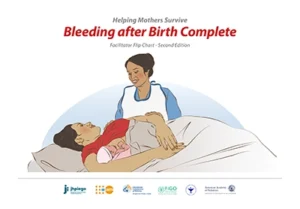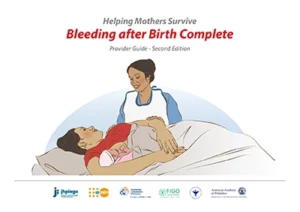Bleeding After Birth Complete
Identify and manage postpartum hemorrhage, the leading cause of maternal, building the capacity of entire teams.
Introduction
The first part of the course is intended for all team members who interact with pregnant, laboring, and post-partum women at any level of the health system. The second part covers prevention and management of shock, to enable healthcare providers in the ongoing management of postpartum hemorrhage.
The learning materials available on this page do not reflect the latest updates to the WHO guidelines. Adaptations are currently underway – updated materials will come soon.
If you would like to request the interim Action Plan being developed, please email [email protected].
Learning objectives
- Active management of third stage of labor
- Early detection and basic management of post-partum hemorrhage
- Bimanual compression
- Management of shock
- Manual removal of placenta
- Cervical laceration repair
- Uterine balloon tamponade
- Use of the non-pneumatic anti-shock garment.
Duration
1 or 2 days depending on your audience and facility. Day 1 is for everyone caring for women at birth and Day 2 is for advanced skills for skilled birth attendants.
Facilitator-to-participant ratio
1 facilitator for every group of 6 participants.
Learning materials
Download and preview the materials you will need. You should also have printed materials during a training. You can order printed materials from Laerdal, or download the printing files free of charge to print locally. To calculate how many copies you need, keep in mind that there should be one facilitator for every group of six participants.
These materials are copywrited and should not be altered. Contact us for inquiries about translations and adaptations.
Action Plans
Two posters showing the steps to take during care, to use both during training and as a job aid for clinical practice.
1 set per group (facilitator + 6 participants), and enough to leave at each facility to be used in clinical care.
Select an option
- Action Plan 1 & 2English
- Action Plan 1 & 2Spanish
- Action Plan 1 & 2French

Flip Chart
Paper-based facilitation tool, with guidance for facilitators to demonstrate, lead discussions and support practice.
1 per group (facilitator + 6 participants)
Select an option
- Flip ChartEnglish
- Flip ChartFrench
- Flip Chart – AfricanEnglish
- Flip Chart – InternationalSpanish

Provider Guide
A booklet for every healthcare worker to use during the training and keep afterwards. For reviewing content and practicing skills overtime.
1 per participant
Select an option
- Provider GuideEnglish
- Provider Guide – AfricanEnglish
- Provider GuideSpanish
- Provider GuideFrench

Videos
Assessments
As part of the learning process, every training program includes assessments for the participants. You can download and print the assessments.
- Day 1 Knowledge Check
- Day 2 Knowledge Check
- Day 1 Knowledge Check Answer Key
- Day 2 Knowledge Check Answer Key
- Confidence Assessment
- OSCE 1 AMTSL
- OSCE 2 Retained placenta
- OSCE 3 Atony
- OSCE 4 Uterine balloon tamponade
- OSCE 5 Repair of cervical tear
- OSCE 6 Non-pneumatic anti-shock garment
Looking for online LIFT assessments? Visit laerdal-lift.com
Equipment
Every group of 6 of participants will need these items to practice during the training. The equipment should also be available for practice in the facilities after the training.
- Maternal simulator, we suggest MamaNatalie
- Towel to create clean/sterile area
- Cloths for newborn
- Baby hat
- Scissors
- Clamps
- Ties
- Sample oxytocin vial
- Sample additional uterotonics as used in local setting
- Sample TXA and mock TXA vial and diluent
- Syringe
- Pinard
- Stethoscope
- Urinary catheter & bag
- 3 BP machines – cradle devices
- Resuscitator
- Basin for placenta
- Gloves
- Large floor protector (shower curtain or other)
- Paper/cloth towels for cleaning up spills
- Waste bin
- Tape
- Personal protective equipment
- Optional: Videos and projector or computer
For the blood estimation exercise you will need
- 4 bowls
- 500ml red fruit jam
- A small amount of gauze
- Towel or culturally appropriate cloth
Templates
Download and modify these documents to fit your needs when preparing and evaluating your course.
Package contains:
- Practice coordinator certificate
- Practice Coordinator Orientation Session Plan
- Trainer evaluation
- Participant Evaluation
- Trainer certificate
- Master Trainer Certificate
- Master Trainer Course Agenda
- Participant Certificate
- Participant Course Agenda
- Preperation Checklist
- Room layout
- Clinical Coaching Skills
- Participant Sign-In Sheet
- Practice coordinator evaluation